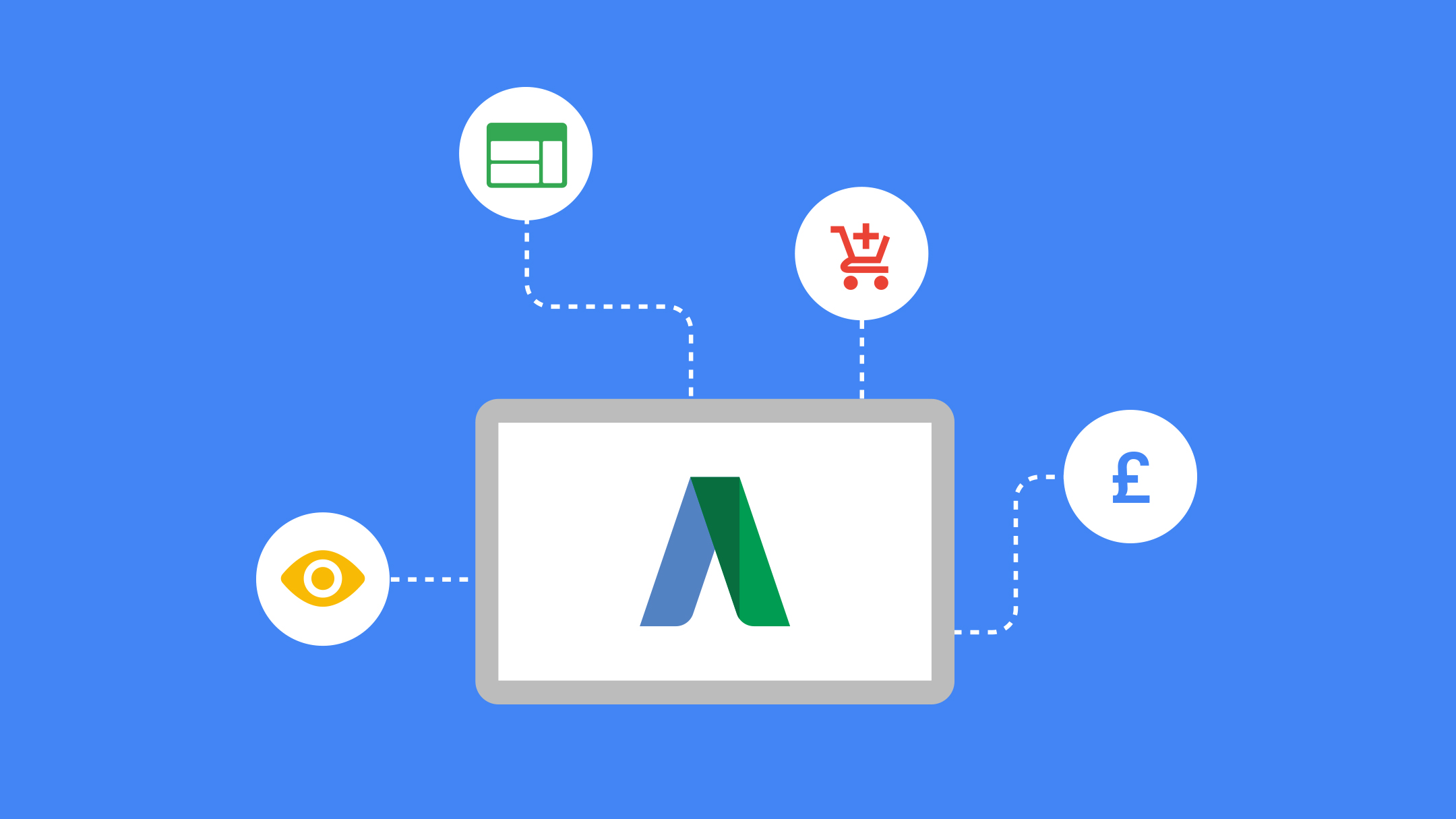Hello!
Machine learning versus manual; that’s what it comes down to when you’re considering Google ad bidding strategies these days.
If you’ve been following Google ads PPC bidding strategies for a few years you’ve probably embraced manual processes for their granularity and control. But there are new automated features on Google that may positively impact the effort you put into these laborious (and some would argue, outdated) workflows.
 Google’s effort to apply automation to ad bidding shouldn’t be surprising. Companies have been talking about and implementing computer automation over the past several years. Google is no exception.
Google’s effort to apply automation to ad bidding shouldn’t be surprising. Companies have been talking about and implementing computer automation over the past several years. Google is no exception.
They have now iterated their way past manual bidding, offering advertisers several Google ads automated bidding options to make your lives a little easier.
Let’s review Google AdWords automated vs. manual bidding to help maximize your ROI with this platform.
Automated Bidding vs. Manual Bidding
There should be no chicken/egg debate; manual bidding came first and was trumped by automation. Automated bidding eliminates manually updating bids for specific kinds of keywords or ad groups on the platform.
According to Google, this kind of computer automation, “sets bids for your ads based on that ad’s likelihood to result in a click or conversion that helps you achieve a specific goal.”
The biggest benefit of Google’s computer automation is it takes the element of human guesswork out of the ad bidding process.
 Manual bidding allows you to set your strategies based on several different types of data (called “signals” in Google-speak), such as:
Manual bidding allows you to set your strategies based on several different types of data (called “signals” in Google-speak), such as:
- Type of device and cross-device usage.
- Target audience.
- Audience demographics like age, gender, and language.
- Browser and/or operating system.
- User interests.
- Previous site visits.
- Physical location.
- End-user ad format preferences.
- Types of onsite behaviors, such as how long the user spent on your site or the value of the products they viewed.
- Day of the week.
- Time of day.
 We’ve looked at the benefits of manual bidding, but what about the drawbacks? One weakness is that you must continuously monitor the performance of your ads and then tweak your bids to optimize conversions.
We’ve looked at the benefits of manual bidding, but what about the drawbacks? One weakness is that you must continuously monitor the performance of your ads and then tweak your bids to optimize conversions.
Ad campaigners do this by analyzing hard data such as A/B testing elements versus click conversions or the performance of specific keywords. This also means that you, well, need to really know what you’re doing.
Fine-tuning processes manually gives you lots of granular flexibility, but if you aren’t a veteran Google advertiser, you could accidentally tank your performance.
If you’re patient, have the time, and a lot of PPC experience, manual bidding may still be the right choice.
In the automated bidding vs. manual bidding debate, manual bidding is preferable if you want an extensive level of control over your ROI.
 The pros of manual bidding over automated bidding include:
The pros of manual bidding over automated bidding include:
- The ability to override performance drops by making bid revisions of underperforming keywords.
- Having control over how aggressively you want to bid on a keyword.
- Controlling exactly when these changes are applied. If you’re a total control freak, or if you need an immediate response, this can be appealing. (Automation can take time to implement.)
Automation is great as long as your PPC account has a decent flow and conversion volume. You shouldn’t assume, either, that the AI is smart enough to be left entirely alone. You’ll also have to wait for the automation to sync after you select this option. It also takes time to “learn,” so ask yourself if you can afford that kind of patience? (If your ad budget is tight, maybe not?)
But there is always a downside to human intervention in what is becoming an increasingly computerized process. Given the evolution to Google ads automated bidding, we believe manual bidding now has several drawbacks to consider:
- Larger accounts make it very difficult to manually monitor performance closely. Thousands of ecommerce keywords, for example, make control increasingly difficult.
- Human error and other inefficiencies create a negative ROI that ultimately correlates with lost opportunities—and lost revenues.
- Manually adjusting bids can evolve quickly into a full-time job. Don’t you have other things to do?
- Audience segmentation is limited and so is the data you use to manually adjust your ad groups, bids, and campaigns.
The third evolution of Google ads bidding strategies is called smart bidding. It might be the future of Google AdWords, though not all PPC experts will agree.
Smart Bidding vs. Manual Bidding
Google ads smart bidding is, more or less, Google ads automation 2.0. Smart bidding handles the process of bid optimization on your behalf. It’s a plug-and-play feature that lets the computer handle the decision-making for your Google ad campaign.
The difference between smart bidding and manual bidding is that Google smart bidding uses machine learning algorithms to optimize your conversions.
 Machine learning is a subclass of automation in artificial intelligence (AI) that allows the computer to learn from behaviors. In the case of Google ads, this type of smart bidding can extrapolate data from bid performance to maximize your investment.
Machine learning is a subclass of automation in artificial intelligence (AI) that allows the computer to learn from behaviors. In the case of Google ads, this type of smart bidding can extrapolate data from bid performance to maximize your investment.
The algorithms built into the system can capture and analyze a broad range of performance parameters. In the digital realm, these features can help optimize your bids automatically in real time—and much faster than a mere human can respond.
One cool feature of smart bidding for your Google ads is that you can customize it to fit your desired strategy. For example, if your Google ads smart bidding goals are for lead generation, you can set the algorithm for maximizing clicks, conversions, conversation value, or target impressions.
 Your options for Google ads smart bidding strategies include:
Your options for Google ads smart bidding strategies include:
- Maximizing clicks to increase website traffic. Google takes into account your campaign budget and the number of keywords and automatically sets bids to get you as many clicks as it can.
- Targeting your impressions to increase Google visibility for your paid ads. If you’re going for the top of the page, selecting this option is a good idea. As you might have guessed, this strategy can be an expensive one—everyone wants to top the results page these days.
- Targeting your cost-per-acquisition, or CPA helps you understand how much you’re spending per every new customer that you acquire. It goes hand-in-hand with lead generation tied to a set cost number. One tip here: Make sure you set reasonable goals that don’t do more harm than good.
- Targeting return on ad spend (ROAS) is probably one of the most common automated (and manual) Google ads bidding strategies that we see out there. It’s a metric designed to justify your paid ad spend budget. Keep in mind you’ll need fairly consistent data over time to track this, but it’s great for scaling a successful campaign. With that caveat, if you’re hard-pressed to optimize revenue on a paid Google ad spend, ROAS as a strategy is the right choice.
- Maximizing your conversion rate. Conversion is a term thrown around a lot in marketing circles. This is a little tricky as you need to be clear on what type of conversion is desirable. It’s easy to make assumptions about what constitutes the kind of conversion you want. For example, is a “conversion” counted as a button click on an ad or a more detailed form fill?
- Optimizing the value of your conversions. If you want to go to the next level beyond maximizing conversions as part of your best Google ads bidding strategy, consider optimizing your conversions. This means focusing on generating higher conversion values within your budget.
As Google becomes more automated, you need to understand these underlying strategies and use them to your advantage. Smart bidding has some definite advantages over manual bidding when looking at these goals.
Another big advantage is that smart bidding uses predictive analytics (i.e., more algorithms) to help you create more accurate predictions for your Google ads bidding strategies.
 The benefits of Google ads smart bidding include:
The benefits of Google ads smart bidding include:
- It’s a “set-it-and-forget-it” feature that saves you time.
- It pulls from a vast array of Google data.
- The computer makes decisions and tweaks your campaign in real-time.
- The reporting for this feature is quite good, allowing for deeper insights into whether your Google ads bidding strategies are working.
On the other hand, incorporating this type of smart bidding strategy for your Google ad campaign also has some drawbacks, such as:
- You can’t control the data that’s being used for the decision-making process.
- You have less control over the budget.
- Google may use data that is too broad or doesn’t accurately reflect your target audience.
- There is a “learning curve” for this computerized process. While machine learning allows the computer to base its adjustments on the past performance of your ads, if the original assumptions for your campaign are off, it will skew performance.
If you’re considering smart bidding over manual bidding, note that the technology is improving rapidly. For now, there are still instances where manual bidding may make more sense.
What About Mobile Bid Adjustment on My Google Ads?
 Mobile bid adjustments are one area where you may want to apply a manual process. Mobile bid adjustments allow you to adjust the percentage of your ad bidding for the target audience that is using their mobile devices to check out your ad.
Mobile bid adjustments are one area where you may want to apply a manual process. Mobile bid adjustments allow you to adjust the percentage of your ad bidding for the target audience that is using their mobile devices to check out your ad.
This is an important tweak that evolved as our target audiences embraced their smartphones as a kind of cultural binky.
Since mobile screens are smaller, end-users see fewer ads on any given search. This can and should change your Google ads bidding strategies for mobile devices.
Keep in mind the historical perspective that Google AdWords came about in the year 2000 or so—more than 20 years later, our mobile-first culture requires some basic adjustments to campaigns that may be doing just fine for desktop.
 Today, 61.9% of Google user interactions in the form of ad clicks occur from a smartphone. So, it makes sense to set up your Google ad campaigns to maximize for mobile.
Today, 61.9% of Google user interactions in the form of ad clicks occur from a smartphone. So, it makes sense to set up your Google ad campaigns to maximize for mobile.
Mobile bid adjustment on Google advertising happens automatically with smart bidding. But a manual bidding strategy also allows you to increase the percentage of bids for end-users using their mobile devices.
Why? Your conversion rate is probably lower on mobile users because, again, screen size. Without a higher bid, an ad that may appear at or near the top of the screen on a desktop may drop down or not appear above the fold on a mobile phone. That costs you customers, so it makes sense to up your budget for mobile users.
Which is Better for You: Google AdWords Automated or Manual Bidding?
The answer to the question of whether automated bidding vs. manual bidding is right for you depends on your expertise, your preferences, and even your trust in an algorithm. Every situation is different.
The question it comes down to is if and when to trust the robots (a set of algorithms, really) over your own skills. It’s like driving a modern vehicle; sometimes you do the steering and sometimes the car tries to keep you in the lane.
 PPC experts will argue that years of experience always trumps a computer algorithm. They may even be right. After all, an algorithm can’t replace human intuition and experience. At least not yet.
PPC experts will argue that years of experience always trumps a computer algorithm. They may even be right. After all, an algorithm can’t replace human intuition and experience. At least not yet.
Also, automation is only as good as the computer nerd behind the code. There is science here, but no art – which could be the exact secret sauce you need to edge out the competition.
Let’s face it; computers are tools. You wouldn’t use a saw to drive a nail, right? The point is that your choice of Google ads bidding strategies should depend on selecting the right tool for the job at hand. So, when should you use smart bidding vs. manual bidding?
 Use Google smart bidding when you:
Use Google smart bidding when you:
- Need to manage efficiencies in your AdWord account by keeping track of keyword impressions, CTR, and conversions. Automation allows you to set an alert if the CTR drops below a certain threshold. You can then resort to manual tweaks to improve your results.
- Have a huge paid search account that emphasizes and calls out top performing phrases.
- Have a lot of historical data to draw from and have very specific goals.
- Lack the time or expertise to handle manual processes.
 Stick with manual bidding for:
Stick with manual bidding for:
- Granular control for small campaigns with small budgets.
- When you have less than 30 days’ worth of consumer data to study.
- When you want to trust your gut and experience and control the process.
- When you have a lot of time to monitor the campaign results.
Today, the best Google ads bidding strategy likely incorporates an element of art and science tied to both automated and manual processes. Selecting the right tool requires testing all of the features available to you and measuring them against your campaign goals.
Also read:
- 10 Must-Have Big Data Skills to Land in a High Paying Job
- Managed IT Services: One Of The Most Lucrative Business Segments
- Tips for Programming a Car Key
Thank you!
Join us on social media!
See you!






